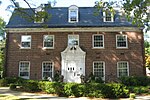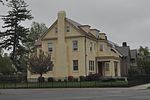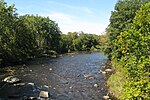Longmeadow Street–North Historic District
Historic districts in Hampden County, MassachusettsHistoric districts on the National Register of Historic Places in MassachusettsLongmeadow, MassachusettsNRHP infobox with nocatNational Register of Historic Places in Hampden County, Massachusetts ... and 1 more
Use mdy dates from August 2023

The Longmeadow Street–North Historic District encompasses a stretch of Longmeadow Street (US Route 5) in northern Longmeadow, Massachusetts, from the town line with neighboring Springfield to Cooley and Westmoreland Streets in the south. It was listed on the National Register of Historic Places in 1994. The district's primarily residential architecture and streetscape is reflective of more than two centuries of development trends, and a late 19th-century desire to maintain a more rural atmosphere.
Excerpt from the Wikipedia article Longmeadow Street–North Historic District (License: CC BY-SA 3.0, Authors, Images).Longmeadow Street–North Historic District
South Park Avenue,
Geographical coordinates (GPS) Address Nearby Places Show on map
Geographical coordinates (GPS)
| Latitude | Longitude |
|---|---|
| N 42.066944444444 ° | E -72.578055555556 ° |
Address
South Park Avenue 116
01106
Massachusetts, United States
Open on Google Maps









